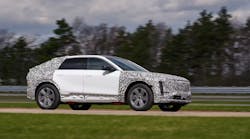General Motors Uses Cisco Wireless for High-Speed Vehicle Tests
At the GM Milford Proving Ground on the northwest outskirts of Detroit, General Motors deploys Cisco wireless networks to gather data on pre-production vehicles during high-speed performance testing. Engineers record up to 200 data channels simultaneously.
This replaces the traditional system of capturing vehicle data locally, analyzing the data off-site, and rerunning the tests later. With real-time data reporting, engineers can adjust performance on the fly during the same session.
“We now have stable and secure wireless network connections in this environment where we have vehicle speeds that can exceed 100 miles per hour,” says Stephen Jenkins, Global Labs director, Proving Grounds Operations and Materials Engineering at GM.
“This connectivity allows us to perform real-time analysis and stream information directly into our Enterprise Data Center without any buffering or human intervention.”
Removing Test Driver Distractions for Added Safety
Tests that run 30 to 60 minutes previously forced drivers to monitor vehicle system performance. With their attention split between driving and monitoring test data, drivers may notice warnings conveyed by onboard instrumentation too late, resulting in safety concerns.
“Examples could include an engine failure due to oil pressure issues, or a brake system failure due to a line leak, both of which can now be detected before the catastrophic system failure,” a GM representative says.
“The benefits are improved driver safety (especially in the brake system example) and improved ability to diagnose/repair system issues (especially in the engine example) which can be difficult after a catastrophic failure.”
GM deploys the wireless backhaul technology, that uses fiber connectivity and wireless communications, for both ICE and EV vehicle tests, in the latter case for calibration of propulsion systems on pre-production vehicles.
Quickly capturing test data is part of GM's larger strategy to develop and deploy vehicles more quickly. Historically, going from initial sketch to production vehicle took at least five years, but in the past few years, GM and other automakers have cut that by more than half.
As Chair and CEO Mary Barra said in her letter to investors announcing $2.9 billion in first-quarter profits, “The GM news ahead of us this year will also be focused on acceleration and growth, especially in EVs. As I’ve shared in this letter, we are now in a rapid launch cycle thanks to investments and initiatives we have undertaken across our entire company over the last several years. They have allowed us to establish an unparalleled foundation on which to execute and scale.”
About the Author
Dennis Scimeca
Technology Editor, IndustryWeek
Dennis Scimeca is a veteran technology journalist with particular experience in vision system technology, machine learning/artificial intelligence, virtual and augmented reality, and interactive entertainment. He has experience writing for consumer, developer, and B2B audiences with bylines in many highly regarded specialist and mainstream outlets.
At IndustryWeek, he covers the continuing expansion of new technologies into the manufacturing world and the competitive advantages gained by learning and employing these new tools.
He also seeks to build connections between manufacturers by sharing the stories of their challenges and successes employing new technologies. If you would like to share your story with IndustryWeek, please contact him at [email protected].
